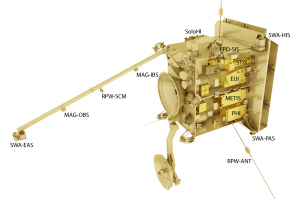Solar Orbiter launch moved to 2018
13 April 2015
The launch of Solar Orbiter, an ESA mission to explore the Sun in unprecedented detail, is now planned to take place in October 2018. The launch was previously targeted for July 2017."The decision to postpone the launch was taken in order to ensure that all of the spacecraft’s scientific goals will be achieved, with all the system’s components adequately tested prior to sending the spacecraft to the launch site," said Philippe Kletzkine, ESA’s project manager for Solar Orbiter.
"This will allow us to ensure that this complex mission will be able to meet all of its scientific objectives."
 |
| Artist's impression of Solar Orbiter. Credit: ESA |
 |
|
Payload accomodation on Solar Orbiter. Credit: ESA |
Solar Orbiter was selected in October 2011 as the first medium-class mission of ESA's Cosmic Vision 2015-2025 Programme. The mission is led by ESA, with important contributions by the US space agency, NASA.
The spacecraft carries a suite of 10 state-of-the art instruments to observe the turbulent, sometimes violent, surface of the Sun and study the changes that take place in the solar wind that flows outward at high speed from our nearest star.
Eight of the instruments will be provided by Principal Investigators through national funding by ESA Member States. A European-led consortium supported by ESA funding and national contributions will provide one instrument, whilst the remaining instrument and an additional sensor will be provided by NASA. The launch from Cape Canaveral in Florida will be aboard a NASA-provided launch vehicle.
Solar Orbiter will take just under three-and-a-half years to reach its operational orbit around the Sun, modifying its path by making close flybys of Earth and Venus. The highly elliptical operational orbit will take it to within 43 million km of the Sun - closer than Mercury, the innermost planet.
During the seven-year mission, the in situ instruments will measure the solar wind plasma, fields, waves, and energetic particles close enough to the Sun where they are still relatively pristine and have not had their properties modified by subsequent transport and propagation processes.
In addition, the remote sensing instruments on Solar Orbiter will send back spectacular images of solar features at a resolution never achieved before. These should provide new insights into what drives the Sun's 11-year cycle of sunspot and flare activity.
The spacecraft's tilted orbit will also enable it to observe the polar regions of the Sun, which are not visible from Earth. This rare view of the solar poles will help us to understand how the Sun's internal dynamo generates its powerful magnetic field. Solar Orbiter should also reveal for the first time what happens when the Sun's magnetic field flips polarity – as it did in 2013.
 |
|
The Structural and Thermal Model of Solar Orbiter, at IABG for testing. Credit: Airbus Defence and Space 2015
|
Meanwhile, the development of the spacecraft continues according to plan. The Structural and Thermal Model has been assembled by the prime contractor, Airbus Defence & Space (UK), and shipped to the IABG test facility near Munich, Germany, where it is now being equipped with sensors that will be used during an intensive test campaign to measure the impact of noise and vibrations on the spacecraft during launch.
The spacecraft Engineering Test Bench, which is used to verify electrical properties of the spacecraft, is undergoing electrical and functional testing at the premises of Airbus Defence & Space, in Stevenage, UK.
Another important step, the Critical Design Review, began as scheduled on 10 March and is proceeding as planned. During the review, all essential aspects of the spacecraft and its interfaces to its ground segment are carefully examined to ensure that the design fulfils the mission requirements.
Preparations for the science ground segment and operational ground segment, aspects of the mission that will require special attention because of the unusual heliocentric operating orbit and the often large distance between the spacecraft and Earth, are also progressing well.



